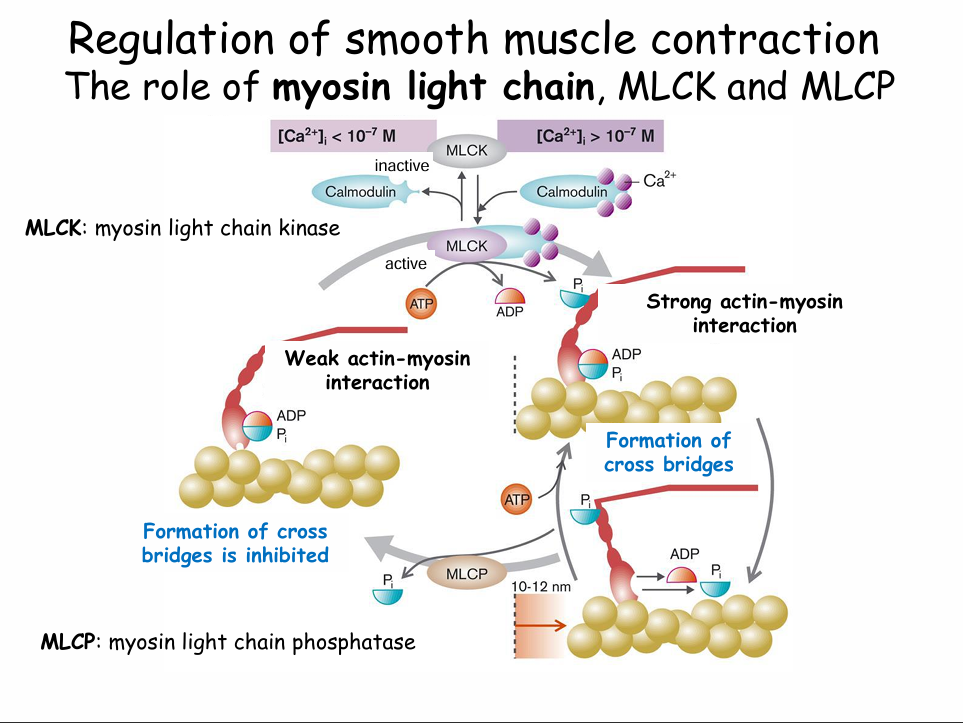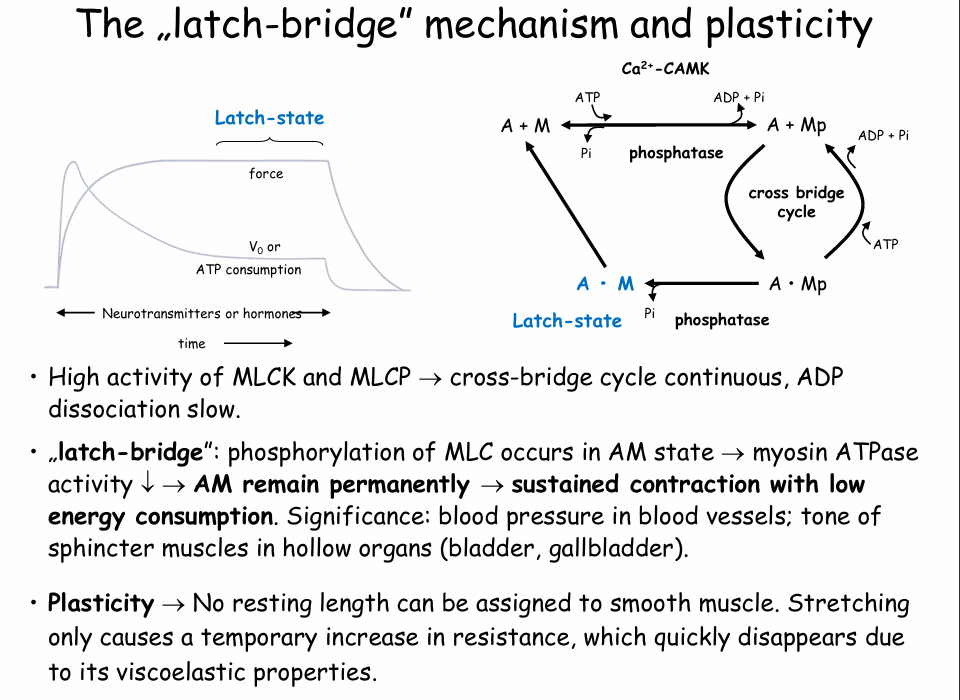
1. Role of Calcium and Calmodulin
Smooth muscle contraction is controlled by the intracellular calcium concentration ([Ca^{2+}]).
When ([Ca^{2+}]) is low (< 10⁻⁷ M) → calmodulin is inactive → MLCK remains inactive → no contraction.
When ([Ca^{2+}]) is high (> 10⁻⁷ M) → calcium binds calmodulin → the Ca²⁺-calmodulin complex activates MLCK.
2. Myosin Light Chain Kinase (MLCK)
Activated MLCK phosphorylates the myosin light chain (using ATP → ADP + Pi).
Phosphorylation of myosin allows strong actin-myosin interaction.
This leads to the formation of cross-bridges → contraction occurs.
3. Actin-Myosin Interaction
Weak interaction: When myosin is not phosphorylated, it cannot strongly bind actin → contraction is inhibited.
Strong interaction: When phosphorylated by MLCK, myosin heads attach firmly to actin → cross-bridges form → contraction.
4. Myosin Light Chain Phosphatase (MLCP)
MLCP removes the phosphate from myosin light chain.
This causes relaxation by preventing strong actin-myosin interactions.
Thus, MLCP counteracts MLCK’s action.
Summary
High Ca²⁺ → Calmodulin activates MLCK → Myosin phosphorylation → Strong actin-myosin interaction → Contraction.
MLCP dephosphorylates myosin → Weak interaction → Relaxation.
So the balance between MLCK (contraction-promoting) and MLCP (relaxation-promoting) determines smooth muscle tone.

1. Normal Cross-Bridge Cycle
Just like in skeletal muscle, smooth muscle contraction involves actin (A) and myosin (M) forming cross-bridges.
When myosin light chain (MLC) is phosphorylated (by MLCK), myosin interacts with actin → cross-bridge cycle occurs → ATP is consumed with every cycle.
2. Latch-Bridge Mechanism
In smooth muscle, there is a special state called the “latch state”.
Here’s what happens:
Phosphorylation of myosin light chain (MLC) can occur while actin and myosin are already bound (AM state).
If MLCP (phosphatase) removes the phosphate while actin and myosin are still attached → the cross-bridge does not detach immediately.
This forms a latch-bridge (A·M): actin and myosin remain strongly attached even though myosin is dephosphorylated.
Result: The muscle maintains force but myosin ATPase activity is very low, so ATP consumption is minimal.
3. Physiological Significance
Latch state = sustained contraction with low energy cost.
This is very important for:
Blood vessels → maintains blood pressure.
Sphincters in hollow organs (bladder, gallbladder, GI tract) → maintain tone without fatigue.
4. Graph on the Left
The graph shows:
Force (top curve) remains relatively constant for a long time.
ATP consumption (lower curve) drops after initial contraction → showing energy-efficient contraction.
This plateau is the latch state.
5. Plasticity of Smooth Muscle
Unlike skeletal muscle, smooth muscle does not have a fixed resting length.
When stretched, it resists briefly, but then the resistance decreases as the muscle adapts → due to its viscoelastic properties.
This allows smooth muscle to maintain function even when organ size changes (e.g., bladder filling).
✅ Summary:
The latch-bridge mechanism allows smooth muscle to maintain contraction (tone) for long periods with minimal energy use. This is crucial for blood pressure regulation and sphincter function. Smooth muscle also shows plasticity, adapting its length and tension based on organ stretching.